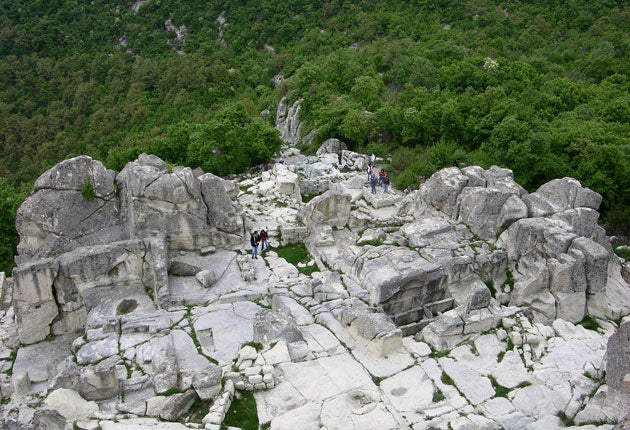This pile of rocks was once the seat of kings
The Bulgarians are unearthing their Thracian heritage. Now visitors can enjoy what's been discovered too, says Robert Nurden

It could be the world's first observatory, its network of little pools acting as mirrors to the stars. It could be a calendar, a kind of Bulgarian Stonehenge. Or it might even be where soothsayers once predicted the future by watching the pattern of flames and the flow of wine down channels carved in the rock.
It might even have been where Alexander first heard the prophecy that he would, one day, conquer the world. It has a sphinx; compasses go haywire when laid on its granite rocks; and it is dangerous to be there in a thunderstorm. Sci-fi geeks claim its flat plateau of rocks was a landing strip for aliens. But no one really knows what Belintash – 4,000 years old and 4,000 feet up in Bulgaria's Rhodope Mountains – was actually for.
Not even such serious-minded archaeologists as Milen Kamarev have much of a clue. "We think it was a Thracian sanctuary to a goddess who was the forerunner of Dionysus," he says. "It could be the rival oracle to Delphi, but we're always changing our mind."
Part of the reason for the uncertainty is that the Thracians – the Orientals of Europe – were a mysterious bunch. They had no alphabet, and they thought the after-life was more important than this one.
What is certain is that in the past 10 years Bulgaria has discovered hundreds of ancient sites and unearthed breathtaking hoards of treasure. Museums are stuffed with exquisite gold and silver artefacts such as the mask pictured above. This is archaeology in the making, and now travel firms are marketing Thracian heritage tours.
The name Thrace may not mean much to you. Yet, Homer said the Thracians were the most populous race after the Indians. For centuries they ruled over most of the Balkans and much of the Aegean. Their horsemanship was legendary and their guerrilla tactics the talk of the ancient world.
Yet, in Bulgaria, pagan festivals such as Kukeri, the ritual that ushers in spring with erotic dances, scary masks and sheep bells, have their roots in Thracian customs. So does the Bulgarians' love of traditional medicine – herbalists from miles around gather on Belintash to pick plants thought to have magical properties for just one night in May. And the nation's fire dancers carry on a craft started by these enigmatic people.
Further east lies Perperikon, another megalithic sanctuary, this time with an altar and a throne. A year ago it was to have been the location for a historical epic starring Nicole Kidman but that project seems to have sunk without trace.
Nearby Tatul is said to house the grave of Orpheus, who was Thracian not Greek – and a real person who, it is said, gave rise to the Orphic cult. At the highest point is a strange double sarcophagus, symbolically midway between sky and earth. Either that, or it is an altar where human sacrifice took place.
The day before, we had been in the Valley of the Kings, where 10,000 mounds of earth point to the presence of the Odrissi. These 2,500-year-old grassy knolls were first thought to be the tombs of nobles, but that's an awful lot of aristocrats to bury. Far more intriguing is the current theory that they were underground temples where the Orphic rites were performed.
The Kazanlak complex has a gorgeous domed fresco: you can only see the replica. At Golyamata Kosmatka the heads of Medusa and Helios guard the inner sanctuary where Seuthes III may have been buried around 300BC. The city he ruled is at the bottom of a reservoir a couple of miles away, cynically submerged by the Communist regime in 1948. Now there's an audacious plan to resurrect the complex by parting the waters with a 20-metre wall. If approved, it will be the world centre for Thracian studies and a visitor attraction with hotels and restaurants.
My shameless pleading to the curator to let me see inside more tumuli bore fruit: he reluctantly shuffled off to get the keys to four of them. What I saw took my breath away: any country in the West would treat them as prized possessions; in Bulgaria they are just another shrug of the shoulders. There was Ostrusha, with its gorgeous roof fresco of a fresh-faced, red-headed woman; Shushmanets, with its Ionic and Doric columns deep underground; the inner sanctum of Helvetia had a stone couch and "pillow" where initiations of acolytes into the Orphic rites involved lying on the marriage bed with the goddess Bedida; and Grifonite, with its twin griffins on either side of the entrance.
On the way to Sofia to see the archaeology museum (more intakes of breath), we stopped off for some Thracian red at the traditional winemaker, Villa Vinifera, whose 1999 Mavrud, the indigenous grape Thracians used to drink, was magnificent.
It's high time the door to Europe's most mysterious people was flung wide open for ever.
Compact facts
How to get there
WizzAir (0904 475 9500; wizzair.com) flies from Luton to Sofia from £84 return. Robert Nurden was a guest of Zig Zag Holidays (00 359 2 980 5102; zigzagbg.com), which runs seven-day Thracian heritage tours from £550 per person.
Further information
Sofia Archaeology Museum (naim.bg), open dailly 10am-6pm, entrance £4. Volunteers for Thracian archaeological excavations this summer should contact Milen Kamarev ( milen-vloges@yahoo.com). Villa Vinifera, Brestovitza (00 359 32 62 40 11; villavinifera.com).
Join our commenting forum
Join thought-provoking conversations, follow other Independent readers and see their replies
Comments
Bookmark popover
Removed from bookmarks